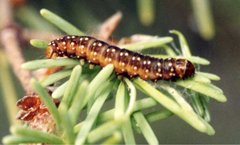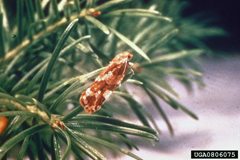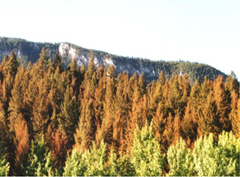Common Name
Western Spruce Budworm
Latin Name
Choristenaura pinus pinus Freeman
Order
Lepidoptera
Family
Tortricidae
Main Host(s): Primarily Douglas-fir (Pseudotsuga menziesii var. glauca), true firs (Pseudotsuga sp.), Larch (Larix sp.), Spruce (Picae sp.).
Life Cycle
The Western Spruce Budworm produces one generation per year, and prefers to feed on Douglas-fir, although true firs (such as Grand fir, Sub-alpine etc.), Larch and some times Spruce can be defoliated by the Western Spruce Budworm. It develops through six larval stages or instars.

After overwintering under bud scales and in twig and flower scars, the Budworm caterpillars emerge in the spring to mine flower buds and older needles. As they grow older and larger, they move to the ends of branches and bore into vegetative buds and cones. They will often web new shoots together to form a protective shelter. As they mature and progress through their various instars, they become free feeders, preferring new foliage. At this time the caterpillars are golden green-brown in color, with a reddish brown head and paired ivory colored dots along their backs; they are about 1 inch (2.5 cm) in length.
Western Spruce Budworm pupation occurs in the webbed foliage between late June to late July, depending upon location and elevation. Pupae are tapered in shape, reddish to light brown with darker bands. In about 2 weeks, pupae hatch out into small grey mottled rusty brown moths, with a wingspan of 1 – 1.1/4 inches. (2 – 2.5 cm).
Female moths lay light-green eggs on the flat bottom surfaces of fir and spruce needles near the tips of branches in July and August. Eggs are laid in masses of about 20, with the eggs overlapping like shingles; each female lays about 150 eggs. Eggs hatch within 12 days, and the small caterpillars disperse on the branches, where they molt once before hibernating under the bark scales (as second instar larvae) on small twigs of the host trees.

Impact & Damage
Western Spruce Budworm is a native insect that cyclically rises to outbreak levels every 35 to 40 years. Plantations, semi-mature and mature fir forests are all at risk, especially in drier forest ecosystems that are found in the interior regions of British Columbia and the Pacific Northwest.
Extensive defoliation can cause significant impacts on individual tree and forest health, especially amongst intermediate or understory trees. Defoliation due to budworm can cause tree and stand mortality over large areas. Surviving stands are often weakened and subsequently succumb to other causes, such as diseases, beetles and fungi. As with many defoliators, even one year of defoliation can have a negative impact upon growth and yield. Several years of defoliation will cause a significant reduction in tree vigour and eventually tree and stand mortality will occur.

Resources
Learn more about Western Spruce Budworm
Quick Links
Contact a Valent BioSciences public health representative.
Contact Us